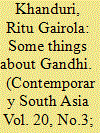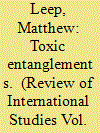| Srl | Item |
| 1 |
ID:
114597


|
|
|
|
|
| Publication |
2012.
|
| Summary/Abstract |
This article focuses on Gandhi's things as a point of intersection - a contact zone of divine and market logics, sensory reality, and subaltern and elite routes of access. Gandhi memorials, his autograph, his ashes, an auction, and the special Gandhi edition Montblanc luxury pen evoke the magic that embraces ordinary things, rendering them extraordinary and desirable. Drawing upon episodes from historical and contemporary contexts, this article prolongs the moment of wonder at why Gandhi continues to cast a spell on a culture industry that transcends national, subaltern, and elite boundaries.
|
|
|
|
|
|
|
|
|
|
|
|
|
|
|
|
| 2 |
ID:
193308


|
|
|
|
|
| Summary/Abstract |
This article explores avian experiences with toxic war processes that unfold across space and time. Joining together three evolving areas of interest in global politics – ontologies of war, interspecies relations, and sensory politics – the article develops a view of war that centres ongoing war processes that affect more-than-human life in and outside of international warzones. Advancing a multispecies form of inquiry attentive to local voices, including Upper Cook Inlet Tribes, the article examines how interspecies relations emerge in national security debates about long-lasting ecological costs of war. Specifically, it offers an analysis of US Department of Defense hearings surrounding the controversy over reopening Eagle River Flats – an Alaskan estuary that had been polluted with white phosphorus munitions – for weapons testing and training during the Iraq War. The article also considers the experiences of two migratory avian communities (northern pintails and tundra swans) with toxic white phosphorus pollution, illustrating more-than-human sensory perspectives on the space and time of war processes. These conceptual and empirical moves reposition national security concerns about wartime risk into a much broader post-anthropocentric perspective.
|
|
|
|
|
|
|
|
|
|
|
|
|
|
|
|